MISSOULA - It's an alarming crime and it's on the rise.
Missoula Police chief Jaeson White tells MTN News domestic violence cases were 18% higher in 2021 than the year before and strangulation cases are included in that. That’s an important distinction because in 2017 the state legislature voted to make strangulation against an intimate partner a felony.
The numbers tell the story of a rising problem in Missoula County. The Missoula Police Department reports there were 55 strangulation investigations in 2019 as compared to 58 in 2021. Meanwhile, the Missoula County Sheriff’s Office reports there were 18 strangulation offenses in 2019 as compared with 22 in 2020 and 31 last year.

Strangulation isn’t just getting choked out it can be deadly. It’s also so dangerous that Missoula is launching a new countywide protocol in response.
“I just thought I was going to die, and he was going to kill me. I was so tired of getting beat up and being strangled, that I couldn’t deal with it anymore,” said strangulation victim Danielle.
It's often called the red flag of domestic violence we never want to talk about. But Missoula Police Chief Jaeson White says “serious issues need serious conversation." A new public service announcement you’ll soon see is part of training and a new countywide protocol for first responders on domestic abuse calls.

“We are now asking our officers to take a little bit closer look into a violent situation and to see if the crime of strangulation has occurred,” White explained.
Almost all states now have some sort of felony strangulation law on the books that can put an abuser behind bars longer. Montana made it a felony to strangle a partner or family member in 2017 and to understand why you have to understand the crime.

“It’s the quickest way to kill someone without leaving a mark,” explained forensic nurse examiner Cat Otway.
"It leads to someone wanting to assert control over that person and it’s the last stop before actually killing someone,” added White.
Even if a victim survives the initial attack, they could later have a stroke or suffer permanent injuries. One Emergency Room doctor explained the neck is considered high-value real estate on the body because it doesn’t take that much pressure to kill.
“The pressure on the neck is so minimal to render someone unconscious. Only four pounds of pressure on the jugular vein for ten seconds and someone could become unconscious. Only ten pounds of pressure on the carotid artery stops the blood flow to the brain for ten seconds and your victim is potentially unconscious. And we were treating it for so long like it was just a slap in the face or a kick or a punch. In fact, it’s one of the most deadly forms of domestic and intimate family violence.” - forensic nurse examiner Cat Otway
Otway — who works with the Missoula First Step resource center at Saint Patrick Hospital — has trained law enforcement officers across the country to help them recognize signs of strangulation on the scene. And, it’s not as obvious as you’d think.
“Most of the time, you’re not going to see one external visible injury on the victim’s neck. I’ve taken care of patients who were strangled eight years ago and to this day their voice has not returned back to normal,” Otway said. “I’ve got patients to this day that can't eat solid food as a result of their strangulation.”
“You always think it will get better and it’s like, I’ll never do that again. But then it just—I feel like once you just start letting it happen, it just escalates,’ explained Danielle.

Some victims will die months, weeks, or even years after the attack as a result of a stroke after an injury to their carotid artery. That’s why first responders are getting the extra training — to find the right words and find the evidence of a strangulation and get the victim help, even if they’re the ones minimizing the attack.
It’s a big enough deal that this month, a new, countywide strangulation protocol begins.
“That is the sole purpose of this, so nothing falls through the cracks. A piece of that protocol includes training. And part of the philosophy we have is a trauma-informed interview technique where we’re not going to be judgmental. We’re just going to get the facts, and so, that way the victim can get the justice the victim deserves, making sure it’s a comfortable environment so a victim can disclose all of the things that may have occurred. So, we can, one, get them medical treatment that they need; two, get them victim services that they need, and three, get a case that is able to be prosecuted.” - Missoula Police Chief Jaeson White
“It’s so interesting that strangulation is so much more common than we realized, but also so much more serious than we ever gave it credit for,” observed Otway.
"If it happens once, you give them another chance because they can change. But if it keeps happening, it’s probably time to do something about it, and talk to someone about it because it could escalate and it could be your life,” Danielle told MTN News.
A person convicted of a first offense of strangulation of a partner or family member faces a fine up to a $50,000 fine and five years in prison. The penalties also increase the more times it happens.
Available Resources
- Student Advocacy Resource Center 24-hour crisis line: 406-243-6559
- Missoula YWCA 24-hour Crisis Line: 406-542-1944
- Crime Victim Advocate Program: 406-258-3830
- Missoula city, county and University of Montana law enforcement: 911






